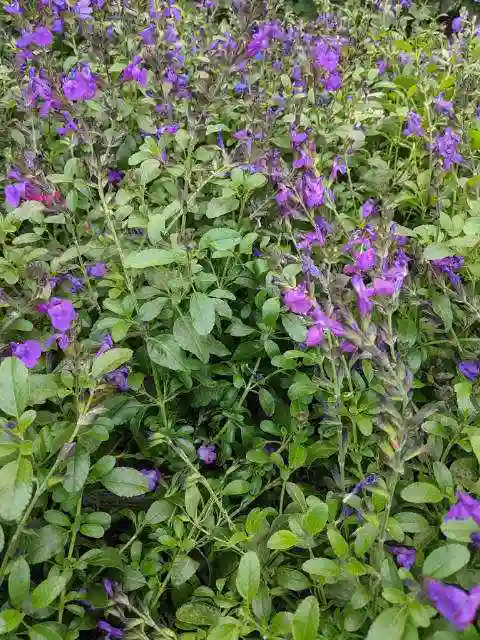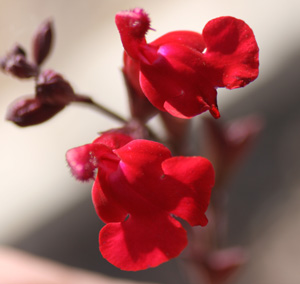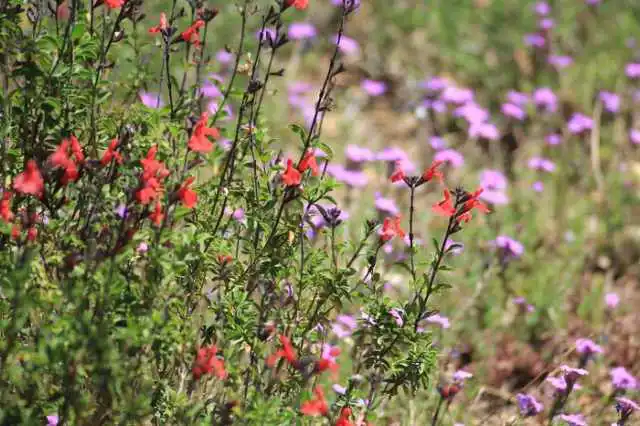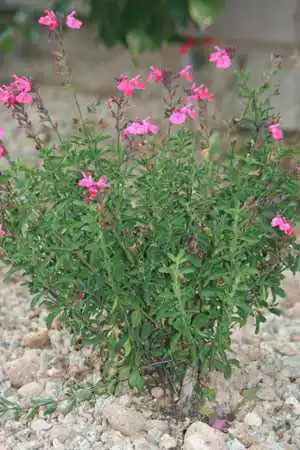Are you looking to create a hummingbird garden or adding an easy to care for perennial to your garden? If so, you may want to grow Salvia in gardening zone 9b.
This post may contain affiliate links. If you purchase after clicking an affiliate link we may receive small commission at no cost to you. As an Amazon Associate I earn from qualifying purchases. Please read my disclosure policies.
Salvia is from the sage family Lamiaceae family, which is also known as the mint family. The leaves have a minty scent.
Salvia can be found in a variety of colors. The hummingbirds in our yard love this plant.
Everything You Need to Know to Grow Salvia in Gardening Zone 9b
- When and How to Plant Salvias
- Types of Salvias to Grow
- How to care for Salvia
- Does the plant attract or deter any wildlife?
- When does it bloom?
When & How to Plant Salvias
In Phoenix we’re in luck because Salvias actually prefer our alkaline and rocky soil. They do best in well-draining soil. If your garden soil is heavy or clay-like, consider amending it with compost or sand to improve drainage.
Salvias prefer a slightly acidic to neutral pH, ideally between 6.0 and 7.0.
Salvias You can Grow In Phoenix or Gardening Zone 9b
- Autumn Sage, Salvia greggi. This type is drought-tolerance and perfect for warmer climates like Phoenix. You can choose from a range of colors from red to pink and white.
- Mexican Bush Sage, Salvia leaucantha, is perfect as a focal point in your garden. Velvety, purple-and-white flowers adorn this fast growing sage.
- Scarlet Sage, Saliva coccinea. This type is known for it’s striking red color to add a pop to your garden.
- Tropical Sage, Salvia elegans. Also called Pineapple Sage. We love this pretty sage for it’s bright red flowers and pineapple-scented leaves.
How to Care for Salvias
Salvias thrive in full sun, which means they need at least 6 to 8 hours of direct sunlight each day. In the intense Arizona sun they prefer morning sun and afternoon partial shade.
Salvia loves the sun and can get leggy in shade. In the intense Arizona sun they prefer morning sun and some afternoon shade.
We have Salvia planted on the east side of our home where they receive full morning sun and the south side of our house.
Once established, Salvias are fairly drought-tolerant. It is native to Texas and Mexico and does quite well in Phoenix, Arizona.
Water them regularly when they are first planted to help them establish a strong root system. After that, you can reduce watering to about once a week, allowing the soil to dry out between waterings.
This beautiful plant varies in size. Depending on the variety salvia may grow one to four feet high and up to three feet wide.
Does the Flowers Attract or Deter Wildlife?
Salvia is a magnet for hummingbirds. It is also attractive to birds and butterflies.
In our yard the hummingbirds return everyday to this pollinator plant and we enjoy watching them sip the nectar. Deer and rabbits will usually leave this plant alone.
Salvia Blooms: Height and Available Colors
At the nurseries in Phoenix, Salvia greggi, is pretty popular.
Several different cultivators ranging from purple, blue, deep reds to lighter pinks are available at local nurseries including: ‘Lipstick’, ‘Flame’, ‘Furman’s Red’, ‘Rosea’



Depending on the variety and your climate, they can bloom from late spring through fall. In gardening zone 9b, which covers parts of Arizona, Texas, and California, you can expect Salvias to start blooming as early as April and continue to dazzle you with their flowers until the first frost, often well into November.
Best Time of Year to Plant Salvia
The best time to transplant Salvia in gardening zone 9b or in Phoenix is mid-February and March. This is when you’ll see the most choices in variety at the local nurseries.
If you’re planting by seed start planting in the fall. Seeds should start to germinate in a couple weeks.
Salvia Pests
The plant seems susceptible to mealy bugs. To deter mealy bugs plant thyme or lavender near Salvia.
How to Propagate Salvia
Propagate Salvia through seeds, cuttings, or division. Here’s a quick rundown of each method:
- Seeds: Start seeds indoors 6-8 weeks before the last frost date. Sow them on the surface of the soil and keep them moist until they germinate. Transplant seedlings outdoors after the danger of frost has passed.
- Cuttings: Take 4-6 inch cuttings from healthy plants in spring or early summer. Remove the lower leaves and dip the cut end in rooting hormone before planting it in a pot with a mix of perlite and peat. Keep the soil moist and place the pot in a warm, bright location.
- Division: Every 2-3 years, divide the plants in early spring or fall. Dig up the entire plant and carefully separate the roots into smaller clumps. Replant the divisions in well-prepared soil.


